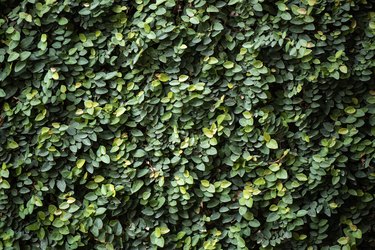
Call it rooting ficus vine, creeping fig or climbing fig, but Ficus pumila (USDA plant hardiness zones 9-11) is a fast grower (up to 15 feet) that can be an annual ground cover, a trailing creeper or an indoor plant. Some experts call it tiny and tough because it's excellent at what it does but warn that you will need to control it if you don't want it to take over your garden. It has pretty little heart-shaped leaves and figs, although you might not find the latter to be all that tasty. Also, be aware that the foliage is poisonous to humans and pets.
Planting Creeping Fig
Video of the Day
Creeping fig prefers partially shaded locations indoors and outdoors, so look for bright spots with indirect light. They need well-draining soil with a slightly acidic pH. If you want to grow creeping fig in a pot, you'll need to be sure to use a container with drain holes. You should water these plants regularly until the roots are established during the first growing season, and after that, water as needed when the top inch of soil is dry.
Video of the Day
Otherwise, creeping fig care is relatively simple. Don't prune this plant until you see new growth in the early spring and avoid doing so in the autumn or winter. You'll also want to wear gardening gloves because the stems contain a milky sap that can be irritating to the skin (not to mention messy). The main creeping fig problems to look for include mealybugs, aphids and the plant turning brown from a lack of humidity. Use natural pesticides, such as neem oil. Some gardeners warn that the milky sap makes creeping fig attach to certain surfaces, like mortar or cement, and can be hard to remove, so watch where it spreads.
How to Propagate Creeping Fig Vine
If you need to know how to propagate creeping fig vine, it is remarkably easy and has a high success rate. All you need to get started is a jar of clean water and a cutting. Snip off a 4-inch-long stem and strip away the bottom two-thirds. Put the cutting in a small jar and add enough water to cover the exposed end. Then, you can place the jar on a windowsill.
You can also propagate creeping figs in a mixture of 90 percent perlite and 10 percent peat moss. Either way, you should see small roots forming in about three weeks. After six to eight weeks, the roots should be healthy enough that you can transplant the plant into the soil. Some experts recommend taking cuttings in midspring or summer for the fastest root development. Once they're planted, keep them moist but do not overwater them.
More to Know About Creeping Fig
Creeping fig is amazingly easy to propagate because every one of its small leaf nodes has the potential to send out new roots. Like ivy, it will pretty much attach itself to any surface. The main trunk can get thick, but this vine is not known to be invasive. They're great for decorating walls, porches and patios.
Climbing figs do best in temperatures ranging from 55 to 75 degrees Fahrenheit, and if you grow them indoors, they'll need an east- or west-facing window; artificial light is also suitable for them. You can fertilize these plants once a month in the spring and summer with a good houseplant food diluted to half its recommended strength. You can also fertilize them in the fall and winter, but you will want to reduce the fertilizing to every other month. You should water them less in the winter.